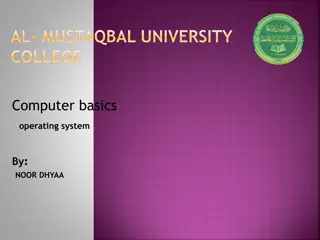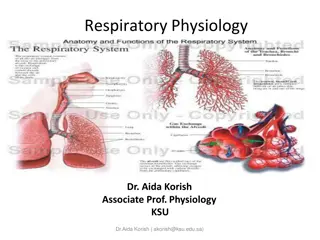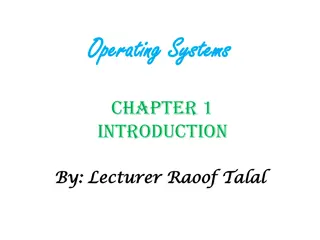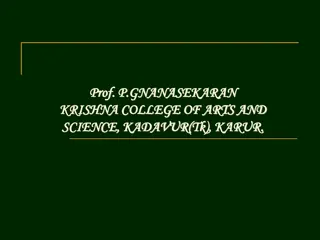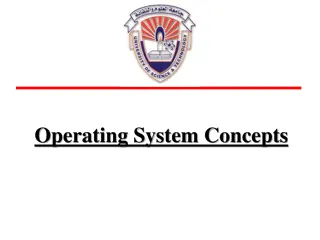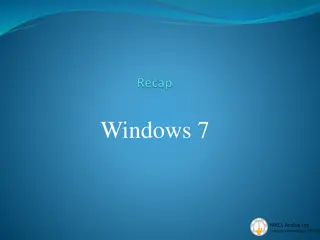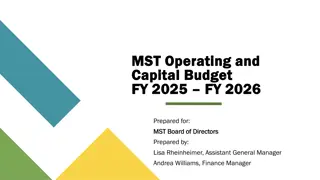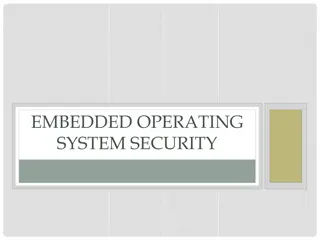Understanding Operating System Services and Functions
An operating system provides services for both users and programs, including user interfaces, program execution, I/O operations, file-system manipulation, communication between processes, error detection, resource allocation, accounting, and protection/security measures. These functions ensure efficient system operation, user productivity, and system integrity.
Download Presentation

Please find below an Image/Link to download the presentation.
The content on the website is provided AS IS for your information and personal use only. It may not be sold, licensed, or shared on other websites without obtaining consent from the author. Download presentation by click this link. If you encounter any issues during the download, it is possible that the publisher has removed the file from their server.
E N D
Presentation Transcript
Operating Systems Operating Systems Chapter 2 By By: Lecturer : Lecturer Raoof Raoof Talal Talal
2.1 Operating System Services An operating system provides certain services to programs and to the users of those programs. One set of operating-system services provides functions that are helpful to the user. User interface: Almost all operating systems have a user interface (UI). This interface can take several forms. One is a command-line interface (CLI), which uses text commands. Another is a batch interface, in which commands are entered into files, and those files are executed. Most commonly a graphical user interface (GUI) is used. Here, the interface is a window system with a pointing device. Some systems provide two or all three of these variations.
Program execution: The system must be able to load a program into memory and to run that program. The program must be able to end its execution, either normally or abnormally (indicating error). I/O operations: A running program may require I/O, which may involve a file or an I/O device. For efficiency and protection, users usually cannot control I/O devices directly. Therefore, the operating system must provide a means to do I/O. File-system manipulation: The file system is of particular interest. Programs need to read and write files and directories. They also need to create and delete them by name, search for a given file, and list file information.
Communications: sometimes one process needs to exchange information with another process. Such communication may occur between processes that are executing on the same computer or between processes that are executing on different computer systems tied together by a computer network. Error detection: The operating system needs to be constantly aware of possible errors. Errors may occur in the CPU and memory hardware (such as a memory error or a power failure), in I/O devices (such as a parity error on tape, a connection failure on a network, or lack of paper in the printer), and in the user program (such as an arithmetic overflow, an attempt to access an illegal memory location). For each type of error, the operating system should take the appropriate action to ensure correct and consistent computing.
Another set of operating-system functions exists not for helping the user but rather for ensuring the efficient operation of the system itself. Resource allocation: When there are multiple users or multiple jobs running at the same time, resources must be allocated to each of them. Accounting: We want to keep track of which users use how much and what kinds of computer resources. This record keeping may be used for accounting (so that users can be billed) or simply for accumulating usage statistics. Protection and security: Protection involves ensuring that all access to system resources is controlled. Security of the system from outsiders is also important. Such security starts with requiring each user to authenticate him or herself to the system, usually by means of a password, to gain access to system resources.
2.2 User Operating System Interface There are two fundamental approaches for users to interface with the operating system. a command-line interface. The second approach a graphical user interface (GUI). 2.2.1 Command Interpreter Some operating systems include the command interpreter in the kernel. Others, such as Windows XP and UNIX, treat the command interpreter as a special program that is running when a job is initiated or when a user first logs on. On systems with multiple command interpreters to choose from, the interpreters are known as shells. For example, on UNIX and Linux systems, there are several different shells a user may choose from.
2.2.2 Graphical User Interfaces A second strategy for interfacing with the operating system is through a user friendly graphical user interface (GUI). Rather than having users directly enter commands via a command-line interface, a GUI allows provides a mouse-based window-and- menu system as an interface. A GUI provides a desktop where the mouse is moved to position its pointer on images, or icons, on the screen (the desktop) that represent programs, files, directories known as a folder , and system functions. Graphical user interfaces first appeared due in part to research taking place in the early 1970s at Xerox PARC research facility.
2.3 System Calls (let it now) System calls provide an interface to the services made available by an operating system. These calls are generally available as routines written in C and C++, although certain low level tasks (for example, tasks where hardware must be accessed directly), may need to be written using assembly- language instructions. Let's first use an example to illustrate how system calls are used: writing a simple program to read data from one file and copy them to another file. The first input that the program will need is the names of the two files: the input file and the output file. These names can be specified in many ways, depending on the operating-system design.
Once the two file names are obtained, the program must open the input file and create the output file. Each of these operations requires system call. Now that both files are set up, we enter a loop that reads from the input file (a system call) and writes to the output file (another system call). Finally, after the entire file is copied, the program may close both files (another system call), write a message to the console or window (more system calls), and finally terminate normally (the final system call). As we can see, even simple programs may make heavy use of the operating system. Frequently, systems execute thousands of system calls per second.
Most programmers never see this level of detail, however. Typically, application developers design programs according to an application programming interface (API). The API specifies a set of functions that are available to an application programmer Three of the most common APIs available to application programmers are the Win32 API for Windows systems, the POSIX API for POSIX-based systems (which includes virtually all versions of UNIX, Linux, and Mac OS X), and the Java API for designing programs that run on the Java virtual machine.
2.3.1 Example C program invoking printf( ) library call, which calls write( ) system call. As shown in figure 2.1.
2.3.2 Types of System Calls (only list) System calls can be grouped roughly into five major categories: 1. Process control 2. file manipulation 3. device manipulation 4. information maintenance 5. Communications
Process control o end, abort o load, execute o create process, terminate process o get process attributes, set process attributes o wait for time o wait event, signal event o allocate and free memory File management o create file, delete file o open, close o read, write, reposition o get file attributes, set file attributes
Device management o request device, release device o read, write, reposition o get device attributes, set device attributes o logically attach or detach devices Information maintenance o get time or date, set time or date o get system data, set system data o get process, file, or device attributes o set process, file, or device attributes Communications o create, delete communication connection o send, receive messages o transfer status information o attach or detach remote devices






